
Wet snow may cause flooding in the Upper Mississippi.
Heavy, wet snow that pounded upper Wisconsin and Minnesota is expected to cause flooding this spring along the upper Mississippi River, and it could be considerable. The National Weather Service released a spring flooding outlook Thursday, saying the risk is “much above normal.” In Louisiana, Monday’s 28-day forecast by the Lower Mississippi River Forecast Center continues to show water at minor flood levels at some locations above Baton Rouge, and the river should have an initial crest of 13.1 feet at the Carrollton Gauge in New Orleans on April 12. Official flood stage in the city is 17 feet, but levees and floodwalls protect to a height of about 25 feet. The upper Mississippi prediction is driven almost entirely by heavy snowfall. The upper Midwest was walloped with such storm systems, especially over the last six weeks.
nola.com
The snow pack is thicker and wetter so more water will come out of it.
Snow in the region has been wetter than usual this winter, which means an abnormally high amount of water is trapped in the snowpack and ready to melt, said Jordan Wendt, service hydrologist for the National Weather Service in La Crosse. Many inches of water are stored in the snowpack covering the basins of the St. Croix, Chippewa and Wisconsin rivers — which drain into the Mississippi. “If it all melted at once, it would be the equivalent of getting eight inches of rain at once,” he said. Though the Midwest and Great Plains experienced drought last summer, slowing down commerce on the Mississippi, rain and snowfall have brought the river and its tributaries back to normal levels, Wendt said. And frost depth, which affects how much water can soak into the ground before it starts running off of it, is shallower than normal.
At the head of the Mississippi there is an increase threat of flooding.
Along the river as it flows out of the Twin Cities, some sites currently have more than a 50% chance of seeing major flooding over the next 90 days, according to the Weather Service flood outlook. As it flows south and forms the border with Wisconsin, some sites have more than a 50% chance of seeing moderate flooding. The last time the river’s mainstem saw a similar flood outlook was in 2019, when long-lasting floodwaters caused an estimated $20 billion in damage to public and private property and crop losses, according to the National Oceanic and Atmospheric Administration. Many spots along the river were at or above flood stage for the majority of that year, an unusual occurrence. If the snow melts steadily and the region doesn’t get more snow, or rain, Wendt said the risk of flooding will decrease. But the snow needs to melt slowly, giving the river time to move the extra water.
A slow melt will delay or prevent flooding but if it warms up and it all melts at once the flooding is almost assured.
On the flip side, the worst-case scenario would be rapid warming. If colder temperatures stick around and the snowpack stays until April, it’s more likely to be melted quickly by a string of 50- or 60-degree days, which could also be punctuated by extra precipitation from a thunderstorm, Wendt said. It’s likely that the region will experience below-normal temperatures for the next few weeks, according to National Weather Service data. While significant Mississippi River flooding could occur, the flood risk is near normal for tributaries in Wisconsin and Minnesota that lead to the river, according to the outlook, and could be lower than normal in Iowa tributaries. The Mississippi is more likely to flood because it drains such a vast region, with more than 21,000 miles of other rivers joining it by the time it reaches Dubuque, Iowa. If all of that water makes its way south, flood control measures could be activated along portions of the river to protect cities and towns. In Louisiana, the Army Corps could open two spillways to relieve the swollen river, which can have wide-ranging ecological impacts.
Even if it floods, we are not looking unto April or may for this to happen.
Flooding events on the Mississippi River typically unfold slowly, Wendt said, and it’s likely that the river won’t reach flood stage in the La Crosse area until late April or early May. That gives surrounding communities time to prepare, but everyone should be monitoring the situation, he said. “It’s almost not a question of whether or not we do flood, but how severe it’ll be,” Wendt said.
Since water runs down hill we may see a rise in the river here.



